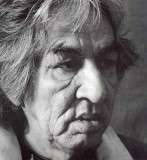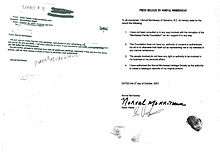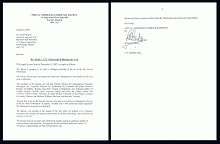Norval Morrisseau
Norval Morrisseau, CM (March 14, 1932 – December 4, 2007),[1] also known as Copper Thunderbird, was an Indigenous Canadian artist from the Bingwi Neyaashi Anishinaabek First Nation. Known as the "Picasso of the North", Morrisseau created works depicting the legends of his people, the cultural and political tensions between native Canadian and European traditions, his existential struggles, and his deep spirituality and mysticism. His style is characterized by thick black outlines and bright colors. He founded the Woodlands School of Canadian art and was a prominent member of the “Indian Group of Seven”.
Norval Morrisseau | |
|---|---|
 | |
| Born | March 14, 1932 Beardmore, Ontario, Canada |
| Died | December 4, 2007 (aged 76) Toronto, Ontario, Canada |
| Nationality | Canadian |
| Education | Self taught |
| Known for | Painting |
| Movement | Woodlands Style |
| Awards | CM |
Biography
An Anishinaabe, Morrisseau was born March 14, 1932[2] on the Sand Point Ojibwe reserve near Beardmore, Ontario. His full name is Jean-Baptiste Norman Henry Morrisseau, but he signs his work using the Cree syllabics writing ᐅᓵᐚᐱᐦᑯᐱᓀᐦᓯ (Ozaawaabiko-binesi, unpointed: ᐅᓴᐘᐱᑯᐱᓀᓯ, "Copper/Brass [Thunder]Bird"), as his pen-name for his Anishnaabe name ᒥᐢᒁᐱᐦᐠ ᐊᓂᒥᐦᑮ (Miskwaabik Animikii, unpointed: ᒥᐢᑿᐱᐠ ᐊᓂᒥᑭ, "Copper Thunderbird").
In accordance with Anishnaabe tradition, he was raised by his maternal grandparents.[3] His grandfather, Moses Potan Nanakonagos, a shaman, taught him the traditions and legends of his people.[3] His grandmother, Grace Theresa Potan Nanakonagos, was a devout Catholic and from her he learned the tenets of Christianity.[3] The contrast between these two religious traditions became an important factor in his intellectual and artistic development.[3]
At the age of six, Morrisseau was sent to a Catholic residential school, where students were educated in the European tradition, native culture was repressed, and the use of native language was forbidden. After two years he returned home and started attending a local community school.[4][5][6]
At the age of 19, he became very sick. He was taken to a doctor but his health kept deteriorating. Fearing for his life, his mother called a medicine-woman who performed a renaming ceremony: She gave him the new name Copper Thunderbird.[7] According to Anishnaabe tradition, giving a powerful name to a dying person can give them new energy and save their lives. Morrisseau recovered after the ceremony and from then on always signed his works with his new name.
Morrisseau contracted tuberculosis in 1956 and was sent to Fort William Sanatorium to recover. There he met his future wife Harriet Kakegamic with whom he had seven children, Victoria, Michael, Peter, David, Lisa, Eugene, and Christian.
After being invited by Ontario Provincial Police Constable, Robert Sheppard, to meet the artist, the anthropologist Selwyn Dewdney became an early advocate of Morrisseau's and was very interested in Morrisseau's deep knowledge of native culture and myth. Dewdney was the first to take his art to a wider public.
Jack Pollock, a Toronto art dealer, helped expose Morrisseau's art to a wider audience in the 1960s. The two initially met in 1962 while Pollock was teaching a painting workshop in Beardmore.[8] As Pollock did not drive, Susan Ross whom Morrisseau had met in 1961 [9] and Sheila Burnford drove Pollock to visit Morrisseau at his home to view more of his works.[8][9] Immediately struck by the genius of Morrisseau's art, he immediately organized an exhibition of his work at his Toronto gallery. One of Morrisseau's early commissions was for a large mural in the Indians of Canada Pavilion at Expo 67, a revolutionary exhibit voicing the dissatisfaction of the First Nations People of Canada with their social and political situation.
In 1972, Morrisseau was caught in a hotel fire in Vancouver and suffered serious burns.[10][11] On that occasion, he had a vision of Jesus encouraging him to be a role model through his art. He converted to the apostolic faith and started introducing Christian themes in his art. A year later he was arrested for drunk and disorderly behaviour and was incarcerated for his own protection. He was assigned an extra cell as a studio and was allowed to attend a nearby church.
Morrisseau was the founder of a Canadian-originated school of art called Woodland or sometimes Legend or Medicine painting. His work is influential on a group of younger Ojibwe and Cree artists, such as Blake Debassige, Benjamin Chee Chee, and Leland Bell. His influence on the Woodland school of artists was recognized in 1984 by the Art Gallery of Ontario exhibit Norval Morrisseau and the Emergence of the Image Makers.[12] He spent his youth in remote isolation in northern Ontario, near Thunder Bay, where his artistic style developed without the usual influences of other artist's imagery. As the sole originator of his "Woodland" style he has become an inspiration to three generations of artists. [13]
In 1978, Morrisseau was made a Member of the Order of Canada.[14] He was a member of the Royal Canadian Academy of Arts.[15]
As Morrisseau's health began to decline as a result of Parkinson's disease and a stroke in 1994,[16] he was cared for by his adopted family Gabe and Michelle Vadas. In 2005 and 2006, the National Gallery of Canada in Ottawa organized a retrospective of his work. This was the first time that the Gallery dedicated a solo exposition to a native artist. In the final months of his life, the artist used a wheelchair and lived in a residence in Nanaimo, British Columbia. He was unable to paint due to his poor health. He died of cardiac arrest—complications arising from Parkinson's disease on December 4, 2007 in Toronto General Hospital.[17] He was buried after a private ceremony in Northern Ontario next to the grave of his former wife, Harriet, on Anishinaabe land.[17]
The National Arts Centre, urban ink co-production, Copper Thunderbird, premiered on the Aboriginal Peoples Television Network (APTN) on Monday, February 4, 2008.[18] Norval Morrisseau was honoured with a posthumous Lifetime Achievement Award during the NAAF Awards show in 2008.[19]
Style
Morrisseau was a self-taught artist.[12] He developed his own techniques and artistic vocabulary that captured ancient legends and images that came to him in visions or dreams. He was originally criticized by the native community because his images disclosed traditional spiritual knowledge. Initially he painted on any material that he could find, especially birchbark, and also moose hide. Dewdney encouraged him to use earth-tone colors and traditional material, which he thought were appropriate to Morrisseau's native style.
The subjects of his art in the early period were myths and traditions of the Anishnaabe people. He is acknowledged to have initiated the Woodland School of native art, where images similar to the petroglyphs of the Great Lakes region were now captured in paintings and prints.
His later style changed: he used more standard material and the colors became progressively brighter, eventually obtaining a neon-like brilliance. The themes also moved from traditional myth to depicting his own personal struggles. He also produced art depicting Christian subjects: during his incarceration, he attended a local church where he was struck by the beauty of the images on stained-glass windows. Some of his paintings, like Indian Jesus Christ, imitate that style and represent characters from the Bible with native features. After he joined the new age religion Eckankar in 1976, he started representing on canvas its mystical beliefs.
The cover art for the Bruce Cockburn album Dancing in the Dragon's Jaws is a painting by Norval Morrisseau.
Fakes and forgeries

The prevalence of fakes and forgeries was of deep concern to Morrisseau, particularly during his later years, and he actively sought to remove these from the marketplace.[20]
In 2005, Morrisseau established the Norval Morrisseau Heritage Society (NMHS). The Society is currently compiling a database of Norval Morrisseau paintings to discredit many prevalent Morrisseau forgeries. This committee, not affiliated with any commercial gallery or art dealer, comprises highly respected members of the academic, legal and Aboriginal communities working on a volunteer basis. It is charged with creating a complete catalogue raisonné of Norval Morrisseau artwork. The NMHS is currently researching Morrisseau art, provenance and materials and techniques in order to complete the task assigned to them by the artist. The NMHS continue their work and in 2008, were in Red Lake, Ontario to research additional information and art by the artist.[21]

The Art Dealers Association of Canada (ADAC) issued the following directive in the Winter 2007 newsletter to their membership: "The Art Dealers Association of Canada is enacting a rule and regulation that no certificates of authenticity will be issued by any members of ADAC with respect to any works or purported works by Norval Morrisseau and that the Norval Morrisseau Heritage Society is the sole authority for the authentication of works by Norval Morrisseau." ADAC also revoked the membership of a dealer who failed to comply with this directive.
Morrisseau also engaged in more direct intervention, identifying fake and forged works available for sale, particularly those purported to be painted by him in the so-called "70s style". He wrote to galleries and made sworn declarations identifying items being sold as "fakes and imitations". More than ten sworn declarations [22] were directed to at least seven dealers and galleries during 1993-2007, requesting that fake and forged works be removed or destroyed.[23]
The debate concerning the authenticity of the "70s paintings" commonly found in the marketplace, continues with ongoing litigation.[24]
A 2019 documentary called There Are No Fakes, directed by Jamie Kastner, is investigating an alleged forgery ring that attempted to pass off fake Morrisseau paintings as originals for several years.[23]
Solo exhibitions
- 1961 Hughes Gallery, London, Ontario
- 1962, 1963, 1964 Pollock Gallery, Toronto
- 1965 Hart House Gallery at University of Toronto
- 1965 Galerie Godard Lefort, Montreal
- 1966 Musée du Québec (now renamed Musée National des Beaux-Arts du Québec), Quebec City
- 1966 Galerie Cartier (Co-sponsored by Pollock Gallery), Montreal
- 1968 Art Gallery of Newport (Sponsored by Galerie Cartier), Newport, Rhode Island
- 1969 Galerie St-Paul, St-Paul de Vence, France
- 1972 Pollock Gallery, Toronto
- 1974 Canadian Guild of Crafts, Toronto
- 1974 The Bau-Xi Gallery, Vancouver
- 1974 Pollock Gallery, Toronto
- 1975 Pollock Gallery, Toronto
- 1975 Shayne Gallery, Montreal
- 1976 Pollock Gallery, Toronto
- 1976 Gallery 115, Winnipeg
- 1977 Pollock Gallery, Toronto
- 1977 Graphic Gallery, Vancouver
- 1978 Wells Gallery, Ottawa
- 1978 First Canadian Place (sponsored by the Pollock Gallery), Toronto
- 1979 Pollock Gallery, Toronto
- 1979 The Gallery Stratford, Stratford, Ontario
- 1979 Shayne Gallery, Montreal
- 1979 The McMichael Canadian Collection (Artist in residence), Kleinburg, Ontario
- 1979 Cardigan/Milne Gallery, Winnipeg
- 1980 Canadian Galleries, Edmonton
- 1980 Lynnwood Arts Centre, Simcoe, Ontario
- 1980 Bayard Gallery, New York
- 1981 Pollock Gallery, Toronto
- 1981 Anthony's Gallery, Toronto
- 1981 Anthony's Gallery, Vancouver
- 1981 Thunder Bay National Exhibition Centre, Thunder Bay, Ontario
- 1981 Nexus Art Gallery, Toronto
- 1982 Moore Gallery, Hamilton, Ontario
- 1982 Masters Gallery, Calgary
- 1982 Robertson Gallery, Ottawa
- 1982 The New Man Gallery, London, Ontario
- 1982 Nexus Art Gallery, Toronto
- 1982 Legacy Art Gallery, Toronto
- 1982 Scarborough Public Gallery, Scarborough, Ontario
- 1984 Ontario Place, Toronto
- 1984 Ontario North Now, Kenora, Ontario
- 1985 Norman Mackenzie Art Gallery, Regina, Saskatchewan
- 1986 First Canadian Place (joint exhibition with Brian Marion), Toronto
- 1986 Manulife Centre, Edmonton
- 1987 Gulf Canada Gallery, Edmonton
- 1988 Sinclair Centre, Vancouver
- 1989 The Art Emporium, Vancouver
- 1990 Kinsman Robinson Galleries, Toronto
- 1991 Kinsman Robinson Galleries, Toronto
- 1991 Wallack Gallery, Ottawa, Ontario
- 1992 Jenkins Showler Galleries, White Rock, British Columbia
- 1994 Kinsman Robinson Galleries, Toronto
- 1997 Kinsman Robinson Galleries, Toronto
- 1999 Kinsman Robinson Galleries, Toronto
- 1999 The Drawing Centre, New York
- 2001 Art Gallery of South Western Manitoba, Brandon, Manitoba
- 2001 Canada House Gallery, Banff, Alberta
- 2001 Drawing Center, New York
- 2002 Thunder Bay Art Gallery, Thunder Bay, Ontario
- 2006 Steffich Fine Art, Salt Spring Island, British Columbia
- 2006 National Gallery of Canada, Ottawa
- 2006 Thunder Bay Art Gallery, Thunder Bay, Ontario
- 2006 McMichael Canadian Art Collection, Kleinburg, Ontario
- 2006 Kinsman Robinson Galleries, Toronto
- 2007 Institute of American Indian Arts Museum, Santa Fe, New Mexico
- 2007 The George Gustav Heye Center of the National Museum of the American Indian, New York
- 2011 Kinsman Robinson Galleries, Toronto
See also
- Notable Aboriginal people of Canada
- Indian Group of Seven
References
- "CBC.ca—Iconic Canadian painter Norval Morrisseau dies at 75". Archived from the original on March 23, 2019. Retrieved February 26, 2019.
- Norval Morrisseau. Archived from the original on February 10, 2018. Retrieved February 9, 2018.
- Robertson, Carmen L. (May 3, 2016). "Mythologizing Norval Morrisseau: Art and the Colonial Narrative in the Canadian Media". Univ. of Manitoba Press – via Google Books.
- Barron, Vanessa (November 19, 2019). "Breaking into the art scene with Norval Morriseau".
- "How allegations of a forgery ring are threatening Norval Morrisseau's legacy - Macleans.ca". www.macleans.ca.
- Canada, Truth and Reconciliation Commission of (April 30, 2015). "Canada's Residential Schools: The Final Report of the Truth and Reconciliation Commission of Canada". Truth and Reconciliation Commission of Canada – via Google Books.
- Kennedy, Randy (December 8, 2007). "Norval Morrisseau, Native Canadian Artist, Is Dead" – via NYTimes.com.
- Dear M - Letters From a Gentleman of Excess by Jack Pollock (1989)
- Susan Ross "Painting is a Way of Life"- A Retrospective Exhibition, Thunder Bay Art Gallery June 3 – July 17, 1994 page 15
- DeSoto, Lewis. "Mystery Man".
- Robertson, Carmen L. (May 3, 2016). "Mythologizing Norval Morrisseau: Art and the Colonial Narrative in the Canadian Media". Univ. of Manitoba Press – via Google Books.
- MacKay, Gillian (March 5, 1984). "Salute to a vibrant revolutionary". Maclean's. 97: 62 – via ProQuest.
- "Archived copy". Archived from the original on January 9, 2010. Retrieved October 3, 2009.CS1 maint: archived copy as title (link)
- "Governor General of Canada - Order of Canada". Archived from the original on February 26, 2019. Retrieved February 26, 2019.
- "Members since 1880". Royal Canadian Academy of Arts. Archived from the original on May 26, 2011. Retrieved September 11, 2013.
- "Norval Morrisseau, 76" – via The Globe and Mail.
- "Ojibwa artist's burial ends dispute between caregiver and children" – via The Globe and Mail.
- "NAC English Theatre/urban ink productions (Galiano Island) co-production". Archived from the original on February 27, 2008. Retrieved January 24, 2008.
- "Norval Morrisseau, 75: Famed native painter". thestar.com. December 5, 2007.
- "Morrisseau Experts Hunt for up to 10,000 works (Ottawa Citizen, January 2, 2007. Retrieved December 25, 2012.)". Archived from the original on May 10, 2014. Retrieved December 25, 2012.
- "Norval Morrisseau Heritage Society at the Red Lake Woodland Arts Festival (July 4-6, 2008)" (PDF). Archived from the original (PDF) on October 5, 2013. Retrieved December 26, 2012.
- "Norval Morrisseau's Sworn Declarations". Archived from the original on February 22, 2014. Retrieved December 25, 2012.
- "How Norval Morrisseau, the late 'Picasso of the North,' landed at the centre of a massive forgery ring". CBC Radio. June 17, 2019. Archived from the original on June 18, 2019. Retrieved June 18, 2019.
- "Norval Morrisseau Related Litigation". Archived from the original on December 29, 2012. Retrieved December 25, 2012.
| Wikimedia Commons has media related to Norval Morrisseau. |
Further reading
- Robertson, Carmen. Norval Morrisseau: Life & Work. Toronto: Art Canada Institute, 2016. ISBN 978-1-4871-0087-2
- Norval Morrisseau, Legends of my People, The Great Ojibway, McGraw-Hill Ryerson, Toronto, 1977, ISBN 0070777144
- Jack Pollock, Lister Sinclair, "The Art of Norval Morrisseau", Methuen & Co., USA, 1979, ISBN 0458938203.
- Norval Morrisseau, Donald C. Robinson, Travels to the House of Invention, Key Porter Books Ltd, Canada, 1997, ISBN 1-55013-880-4.
- Basil H. Johnston, The Art of Norval Morrisseau, The Writings of Basil H. Johnston, The Glenbow Museum, Calgary, 1999.
- Norval Morrisseau, Donald C. Robinson, Return to the House of Invention, Key Porter Books Ltd, Canada, 2005, ISBN 1-55263-726-3.
- Greg Hill, Norval Morrisseau: Shaman Artist, Douglas & McIntyre, Canada, 2006, ISBN 1-55365-176-6.
- Marie Clements, "Copper Thunderbird", Talonbooks, Canada, 2007, ISBN 0889225680.